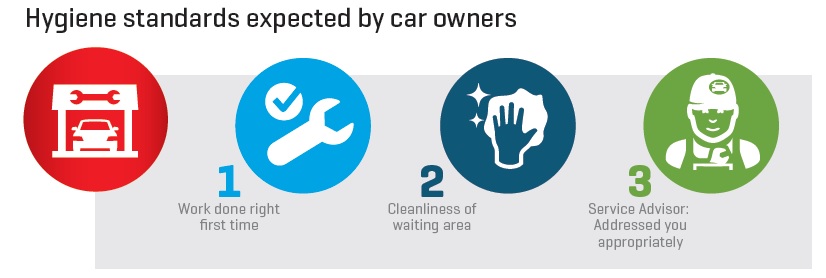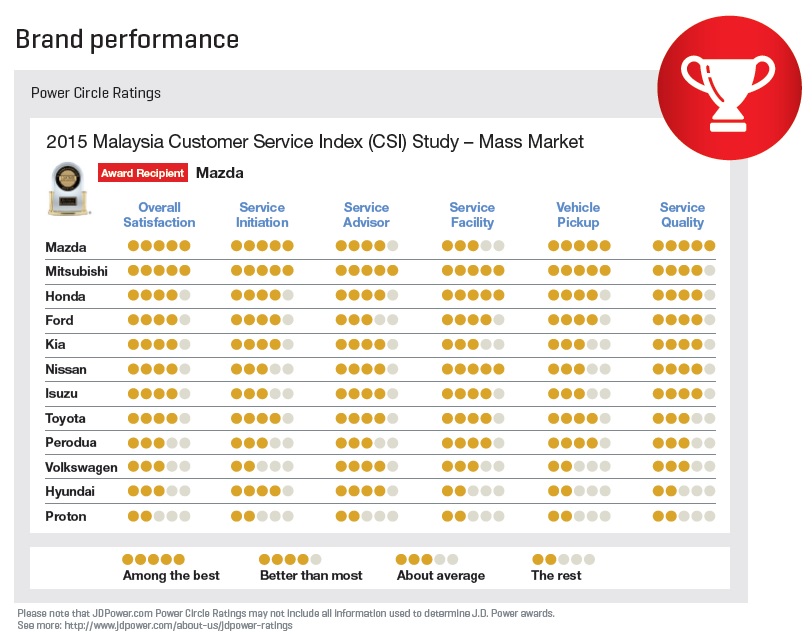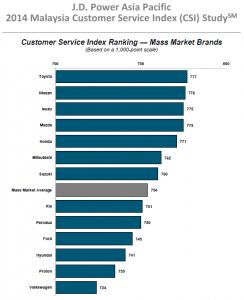For the uninitiated, J.D. Power is an organisation that undertakes market research of major industries since it was founded in 1968, with automotive being one of the core industries. They conduct surveys, capture “the voice of customers” and their behaviour so that companies can improve on their customer satisfaction.

In its 13th year of running, the J.D. Power Asia Pacific 2015 Malaysia Customer Service Index (CSI) Study was released late last month. It measured the overall service satisfaction among car owners (a total of 2,812) who own a mass market branded car (luxury brands not covered) who sent their vehicle to an authorised service centre for maintenance and/or remedial work during the first 12 to 24 months of ownership.

The study evaluates new-vehicle owner satisfaction with the service experience by examining dealership performance in five factors (in order of importance): service quality (32%); service initiation (22%); vehicle pick-up (18%); service advisor (15%); and service facility (13%).
Instead of just showing you which brand scored how many points, we thought it’ll be more interesting to find out how you, the car owner, behaved.
The study revealed that…
Most of you care a lot about your cars…because more than half of the owners surveyed tracked the mileage and service needs of their cars, while more than 2/3 of you schedule your service visits, with nearly 3/4 of owners staying at the service centre while the cars were being fixed. The last point is intriguing in that most of you preferred to lurk around and wait till the car is done. Then again, considering how much we pay for our cars, this may not come as a surprise.

According to you, notification for routine maintenance and establishing contact after the service visit have the most significant impact on satisfaction. It appears that most want to be reminded to service their cars, and look forward to a call after the service appointment to see if everything is OK.
Some of your key expectations were…work to be done right the first time, cleanliness of the waiting area, and whether the service advisor addressed you properly. No real surprises here, there’s nothing more depressing than to make repeated visits to fix the same problem, and while at the service venue, you preferred not to be sitting on soiled sofas with biscuit crumbs, and be addressed by service advisors who are courteous.

However, your expectations have also risen since the 2014 CSI study was done.
Satisfaction among mass market brands averaged 749 index points (on a 1,000-point scale) in 2015, which is a five-point decline from 2014. Car owners expect to receive a higher level of service, with overall satisfaction averaging 815 among the 12 percent of customers who indicate they had a “better-than-expected” service experience, compared with 842 in 2014.

The greatest drop in satisfaction is in service facility, where satisfaction has declined to 773 in 2015 from 785 in 2014. Ease of approach to and convenience of service centres also contributed to the decline in satisfaction in the service facility factor. Looks like it pays for brands to continuously upgrade their service facilities in line with the increasing numbers of cars being put on the road.
Which brand came out tops, which didn’t
Out of the 16 mass market brands surveyed (Chevrolet, Peugeot, Subaru and Suzuki were not ranked due to insufficient sample size), Mazda emerged as the top performer in 2015 – it performed particularly well in service initiation and service quality areas – followed by Mitsubishi and Honda. In line with the lower average score for satisfaction in 2015 (749 against 754 of 2014), Mazda’s winning score of 774 turned out to be one point lower than what it achieved in 2014 (which only earned it third place), while Honda actually shed 11 points in 2015, but still managed to move up from fourth to third in 2015.
 Among the top three in 2015, only Mitsubishi managed to improve its score from 2014 (762 to 773 in 2015) to finish second. Curiously, the top performing brand of 2014, Toyota, was relegated from first to joint fifth (with Isuzu), while Nissan, which was second last year, dropped a couple of places to joint fourth in 2015, alongside Ford and Kia, both of which registered improvements.
Among the top three in 2015, only Mitsubishi managed to improve its score from 2014 (762 to 773 in 2015) to finish second. Curiously, the top performing brand of 2014, Toyota, was relegated from first to joint fifth (with Isuzu), while Nissan, which was second last year, dropped a couple of places to joint fourth in 2015, alongside Ford and Kia, both of which registered improvements.
On the lower half, Perodua moved above the average satisfaction score with 753, while Volkswagen’s recent after-sales efforts seem to be bearing fruit, the German brand improving its score from 724 (2014) to 743 (2015), though it remains below the satisfaction threshold, at least it no longer holds the wooden spoon, which is now back in the hands of Proton.
(Information on this article was sourced from the J.D. Power Asia Pacific 2014 & 2015 Malaysia Customer Service Index (CSI) Study)
